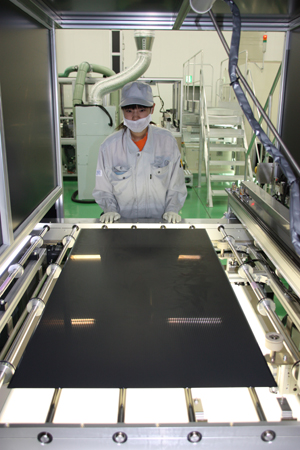Solar Frontier introduces iPhone-thin PV module
 Japan’s Solar Frontier introduced a new thin-film solar photovoltaic module that’s thinner than an iPhone5 this week at PV Japan earlier this week. The company is the world’s largest producer of copper indium gallium selenide (CIGS) thin-film PV. And alongside the thinnest commercial module it also debuted its highest power module to date.
Japan’s Solar Frontier introduced a new thin-film solar photovoltaic module that’s thinner than an iPhone5 this week at PV Japan earlier this week. The company is the world’s largest producer of copper indium gallium selenide (CIGS) thin-film PV. And alongside the thinnest commercial module it also debuted its highest power module to date.
The Solacis neo is a slim, lightweight module that’s only 6.5 millimeters thick, weighing only 8 kilograms (17.6 pounds). “This constitutes a 40% reduction in weight from previous models. The lighter weight, advanced frameless design, increased flex tolerance, all-black appearance, and overall high quality, Made-in-Japan construction make it well-suited to rooftops,” the company said. The Solacis neo uses Solar Frontier’s latest technology and is the thinnest glass substrate module on the market.
While flexible thin-film modules using CIGS are generally much thinner than 6.5 millimeters, They’re not generally as powerful or designed for the lifespan of a stationary rooftop module. And most other PV modules are much thicker. For instance, the other debut, the SF170-S is 35 millimeters thick. It’s also much heavier, weighing in at 20 kilograms (44 pounds).
Still, both panels are far less efficient than their silicon counterparts. SunPower’s E 20 modules using its Maxeon PV cells are over 20 percent efficient at converting sunlight to electricity. And the panels are rated at 435 watts.
Solar Frontier’s SF170-S module is likely closer to 13.8 percent efficient. Still, the thin-films promise cheaper modules compared to silicon. And Solar Frontier boasts, “CIS thin-film modules achieve high output through low-light abilities, low temperature co-efficient, increased initial output after initial exposure to sunlight, and resistance to partial shading.”
Manufacturing of the Solacis modules will begin as soon as October 2013 with shipments happening as soon as October, according to Solar Frontier. However, don’t expect them in the U.S. too soon. The company said manufacture of both products will largely support needs in Japan, where the country has a high demand for solar thanks to it’s feed-on tariff and decision to end reliance on nuclear energy.
As part of the introduction the company also introduced new mounting systems for both series of modules under the moniker Cross One. The company said the new mounting system reduces mounting points and the roof load, and can cut installation time by 40 percent. Between that and the lighter modules promised in Solacis, it should open more roofs to solar without having to require extra work to make them suitable.




